(1) 分离RGB24像素数据中的R、G、B分量
/**
* Split R, G, B planes in RGB24 file.
* @param url Location of Input RGB file.
* @param w Width of Input RGB file.
* @param h Height of Input RGB file.
* @param num Number of frames to process.
*
*/
int simplest_rgb24_split(char *url, int w, int h,int num){
FILE *fp=fopen(url,"rb+");
FILE *fp1=fopen("output_r.y","wb+");
FILE *fp2=fopen("output_g.y","wb+");
FILE *fp3=fopen("output_b.y","wb+");
unsigned char *pic=(unsigned char *)malloc(w*h*3);
for(int i=0;i<num;i++){
fread(pic,1,w*h*3,fp);
for(int j=0;j<w*h*3;j=j+3){
//R
fwrite(pic+j,1,1,fp1);
//G
fwrite(pic+j+1,1,1,fp2);
//B
fwrite(pic+j+2,1,1,fp3);
}
}
free(pic);
fclose(fp);
fclose(fp1);
fclose(fp2);
fclose(fp3);
return 0;
}从代码可以看出,与YUV420P三个分量分开存储不同,RGB24格式的每个像素的三个分量是连续存储的。一帧宽高分别为w、h的RGB24图像一共占用w*h*3 Byte的存储空间。RGB24格式规定首先存储第一个像素的R、G、B,然后存储第二个像素的R、G、B…以此类推。类似于YUV420P的存储方式称为Planar方式,而类似于RGB24的存储方式称为Packed方式。上述调用函数的代码运行后,将会把一张分辨率为500x500的名称为cie1931_500x500.rgb的RGB24格式的像素数据文件分离成为三个文件:
output_r.y:R数据,分辨率为256x256。
output_g.y:G数据,分辨率为256x256。
output_b.y:B数据,分辨率为256x256。输入的原图是一张标准的CIE 1931色度图。该色度图右下为红色,上方为绿色,左下为蓝色,如下所示。
R数据图像如下所示。
G数据图像如下所示。
B数据图像如下所示。
(2)将RGB24格式像素数据封装为BMP图像
BMP图像内部实际上存储的就是RGB数据。本程序实现了对RGB像素数据的封装处理。通过本程序中的函数,可以将RGB数据封装成为一张BMP图像。
/**
* Convert RGB24 file to BMP file
* @param rgb24path Location of input RGB file.
* @param width Width of input RGB file.
* @param height Height of input RGB file.
* @param url_out Location of Output BMP file.
*/
int simplest_rgb24_to_bmp(const char *rgb24path,int width,int height,const char *bmppath){
typedef struct
{
long imageSize;
long blank;
long startPosition;
}BmpHead;
typedef struct
{
long Length;
long width;
long height;
unsigned short colorPlane;
unsigned short bitColor;
long zipFormat;
long realSize;
long xPels;
long yPels;
long colorUse;
long colorImportant;
}InfoHead;
int i=0,j=0;
BmpHead m_BMPHeader={0};
InfoHead m_BMPInfoHeader={0};
char bfType[2]={'B','M'};
int header_size=sizeof(bfType)+sizeof(BmpHead)+sizeof(InfoHead);
unsigned char *rgb24_buffer=NULL;
FILE *fp_rgb24=NULL,*fp_bmp=NULL;
if((fp_rgb24=fopen(rgb24path,"rb"))==NULL){
printf("Error: Cannot open input RGB24 file.\n");
return -1;
}
if((fp_bmp=fopen(bmppath,"wb"))==NULL){
printf("Error: Cannot open output BMP file.\n");
return -1;
}
rgb24_buffer=(unsigned char *)malloc(width*height*3);
fread(rgb24_buffer,1,width*height*3,fp_rgb24);
m_BMPHeader.imageSize=3*width*height+header_size;
m_BMPHeader.startPosition=header_size;
m_BMPInfoHeader.Length=sizeof(InfoHead);
m_BMPInfoHeader.width=width;
//BMP storage pixel data in opposite direction of Y-axis (from bottom to top).
m_BMPInfoHeader.height=-height;
m_BMPInfoHeader.colorPlane=1;
m_BMPInfoHeader.bitColor=24;
m_BMPInfoHeader.realSize=3*width*height;
fwrite(bfType,1,sizeof(bfType),fp_bmp);
fwrite(&m_BMPHeader,1,sizeof(m_BMPHeader),fp_bmp);
fwrite(&m_BMPInfoHeader,1,sizeof(m_BMPInfoHeader),fp_bmp);
//BMP save R1|G1|B1,R2|G2|B2 as B1|G1|R1,B2|G2|R2
//It saves pixel data in Little Endian
//So we change 'R' and 'B'
for(j =0;j<height;j++){
for(i=0;i<width;i++){
char temp=rgb24_buffer[(j*width+i)*3+2];
rgb24_buffer[(j*width+i)*3+2]=rgb24_buffer[(j*width+i)*3+0];
rgb24_buffer[(j*width+i)*3+0]=temp;
}
}
fwrite(rgb24_buffer,3*width*height,1,fp_bmp);
fclose(fp_rgb24);
fclose(fp_bmp);
free(rgb24_buffer);
printf("Finish generate %s!\n",bmppath);
return 0;
return 0;
}通过代码可以看出,该程序完成了主要完成了两个工作:
1)将RGB数据前面加上文件头。
2)将RGB数据中每个像素的“B”和“R”的位置互换。
BMP文件是由BITMAPFILEHEADER、BITMAPINFOHEADER、RGB像素数据共3个部分构成,它的结构如下图所示。
BITMAPFILEHEADER
BITMAPINFOHEADER
RGB像素数据
其中前两部分的结构如下所示。在写入BMP文件头的时候给其中的每个字段赋上合适的值就可以了。
typedef struct tagBITMAPFILEHEADER
{
unsigned short int bfType; //位图文件的类型,必须为BM
unsigned long bfSize; //文件大小,以字节为单位
unsigned short int bfReserverd1; //位图文件保留字,必须为0
unsigned short int bfReserverd2; //位图文件保留字,必须为0
unsigned long bfbfOffBits; //位图文件头到数据的偏移量,以字节为单位
}BITMAPFILEHEADER;
typedef struct tagBITMAPINFOHEADER
{
long biSize; //该结构大小,字节为单位
long biWidth; //图形宽度以象素为单位
long biHeight; //图形高度以象素为单位
short int biPlanes; //目标设备的级别,必须为1
short int biBitcount; //颜色深度,每个象素所需要的位数
short int biCompression; //位图的压缩类型
long biSizeImage; //位图的大小,以字节为单位
long biXPelsPermeter; //位图水平分辨率,每米像素数
long biYPelsPermeter; //位图垂直分辨率,每米像素数
long biClrUsed; //位图实际使用的颜色表中的颜色数
long biClrImportant; //位图显示过程中重要的颜色数
}BITMAPINFOHEADER;BMP采用的是小端(Little Endian)存储方式。这种存储方式中“RGB24”格式的像素的分量存储的先后顺序为B、G、R。由于RGB24格式存储的顺序是R、G、B,所以需要将“R”和“B”顺序作一个调换再进行存储。
下图为输入的RGB24格式的图像lena_256x256_rgb24.rgb。
下图分封装为BMP格式后的图像output_lena.bmp。封装后的图像使用普通的看图软件就可以查看。
(3)将RGB24格式像素数据转换为YUV420P格式像素数据
unsigned char clip_value(unsigned char x,unsigned char min_val,unsigned char max_val){
if(x>max_val){
return max_val;
}else if(x<min_val){
return min_val;
}else{
return x;
}
}
//RGB to YUV420
bool RGB24_TO_YUV420(unsigned char *RgbBuf,int w,int h,unsigned char *yuvBuf)
{
unsigned char*ptrY, *ptrU, *ptrV, *ptrRGB;
memset(yuvBuf,0,w*h*3/2);
ptrY = yuvBuf;
ptrU = yuvBuf + w*h;
ptrV = ptrU + (w*h*1/4);
unsigned char y, u, v, r, g, b;
for (int j = 0; j<h;j++){
ptrRGB = RgbBuf + w*j*3 ;
for (int i = 0;i<w;i++){
r = *(ptrRGB++);
g = *(ptrRGB++);
b = *(ptrRGB++);
y = (unsigned char)( ( 66 * r + 129 * g + 25 * b + 128) >> 8) + 16 ;
u = (unsigned char)( ( -38 * r - 74 * g + 112 * b + 128) >> 8) + 128 ;
v = (unsigned char)( ( 112 * r - 94 * g - 18 * b + 128) >> 8) + 128 ;
*(ptrY++) = clip_value(y,0,255);
if (j%2==0&&i%2 ==0){
*(ptrU++) =clip_value(u,0,255);
}
else{
if (i%2==0){
*(ptrV++) =clip_value(v,0,255);
}
}
}
}
return true;
}
/**
* Convert RGB24 file to YUV420P file
* @param url_in Location of Input RGB file.
* @param w Width of Input RGB file.
* @param h Height of Input RGB file.
* @param num Number of frames to process.
* @param url_out Location of Output YUV file.
*/
int simplest_rgb24_to_yuv420(char *url_in, int w, int h,int num,char *url_out){
FILE *fp=fopen(url_in,"rb+");
FILE *fp1=fopen(url_out,"wb+");
unsigned char *pic_rgb24=(unsigned char *)malloc(w*h*3);
unsigned char *pic_yuv420=(unsigned char *)malloc(w*h*3/2);
for(int i=0;i<num;i++){
fread(pic_rgb24,1,w*h*3,fp);
RGB24_TO_YUV420(pic_rgb24,w,h,pic_yuv420);
fwrite(pic_yuv420,1,w*h*3/2,fp1);
}
free(pic_rgb24);
free(pic_yuv420);
fclose(fp);
fclose(fp1);
return 0;
}从源代码可以看出,本程序实现了RGB到YUV的转换公式:
Y= 0.299*R+0.587*G+0.114*B
U=-0.147*R-0.289*G+0.463*B
V= 0.615*R-0.515*G-0.100*B
在转换的过程中有以下几点需要注意:
1) RGB24存储方式是Packed,YUV420P存储方式是Packed。
2) U,V在水平和垂直方向的取样数是Y的一半
转换前的RGB24格式像素数据lena_256x256_rgb24.rgb的内容如下所示。

转换后的YUV420P格式的像素数据output_lena.yuv的内容如下所示。
(4)生成RGB24格式的彩条测试图
/**
* Generate RGB24 colorbar.
* @param width Width of Output RGB file.
* @param height Height of Output RGB file.
* @param url_out Location of Output RGB file.
*/
int simplest_rgb24_colorbar(int width, int height,char *url_out){
unsigned char *data=NULL;
int barwidth;
char filename[100]={0};
FILE *fp=NULL;
int i=0,j=0;
data=(unsigned char *)malloc(width*height*3);
barwidth=width/8;
if((fp=fopen(url_out,"wb+"))==NULL){
printf("Error: Cannot create file!");
return -1;
}
for(j=0;j<height;j++){
for(i=0;i<width;i++){
int barnum=i/barwidth;
switch(barnum){
case 0:{
data[(j*width+i)*3+0]=255;
data[(j*width+i)*3+1]=255;
data[(j*width+i)*3+2]=255;
break;
}
case 1:{
data[(j*width+i)*3+0]=255;
data[(j*width+i)*3+1]=255;
data[(j*width+i)*3+2]=0;
break;
}
case 2:{
data[(j*width+i)*3+0]=0;
data[(j*width+i)*3+1]=255;
data[(j*width+i)*3+2]=255;
break;
}
case 3:{
data[(j*width+i)*3+0]=0;
data[(j*width+i)*3+1]=255;
data[(j*width+i)*3+2]=0;
break;
}
case 4:{
data[(j*width+i)*3+0]=255;
data[(j*width+i)*3+1]=0;
data[(j*width+i)*3+2]=255;
break;
}
case 5:{
data[(j*width+i)*3+0]=255;
data[(j*width+i)*3+1]=0;
data[(j*width+i)*3+2]=0;
break;
}
case 6:{
data[(j*width+i)*3+0]=0;
data[(j*width+i)*3+1]=0;
data[(j*width+i)*3+2]=255;
break;
}
case 7:{
data[(j*width+i)*3+0]=0;
data[(j*width+i)*3+1]=0;
data[(j*width+i)*3+2]=0;
break;
}
}
}
}
fwrite(data,width*height*3,1,fp);
fclose(fp);
free(data);
return 0;
}从源代码可以看出,本程序循环输出“白黄青绿品红蓝黑”8种颜色的彩条。这8种颜色的彩条的R、G、B取值如下所示。
| 颜色 | (R, G, B) |
| 白 | (255, 255, 255) |
| 黄 | (255, 255, 0) |
| 青 | ( 0, 255, 255) |
| 绿 | ( 0, 255, 0) |
| 品 | (255, 0, 255) |
| 红 | (255, 0, 0) |
| 蓝 | ( 0, 0, 255) |
| 黑 | ( 0, 0, 0) |
生成的图像截图如下所示。








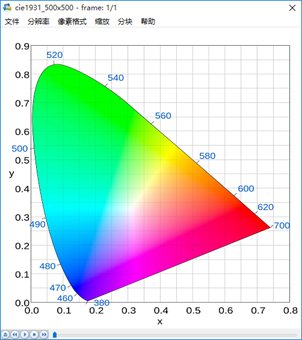
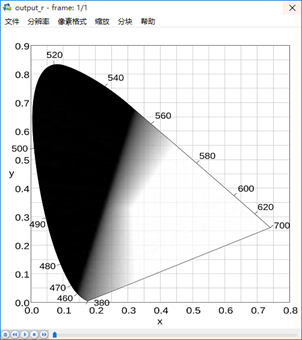
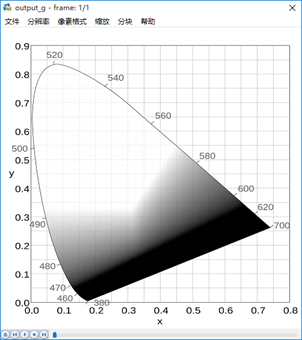
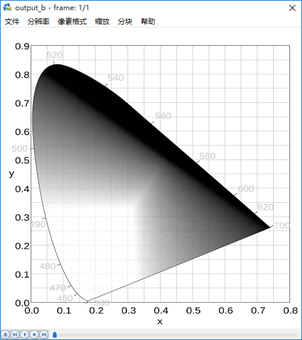



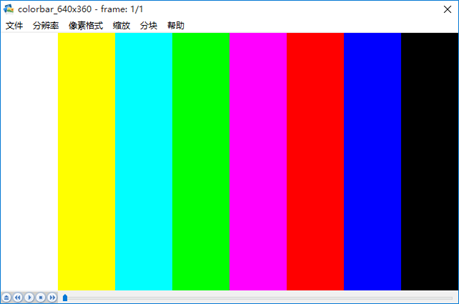














 9668
9668











 被折叠的 条评论
为什么被折叠?
被折叠的 条评论
为什么被折叠?








